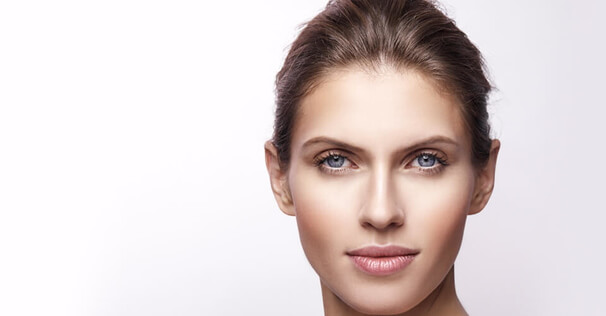Facts on Wrinkle Treatment with Botox®
| Duration: | appx. 1/2 hour |
|---|---|
| Anesthetization: | local anesthesia |
| Treatment: | ambulant |
| Strapping: | none |
| Down time: | none |
| Price: | depending on amount / dose |
| Payment: | directly after treatment in the practice |
Wrinkles give your face character. But is it the character you want?
Nobody is entirely safe from the ravages of time. The impossible-to-miss traces it leaves behind on our faces are called wrinkles. They lend character to the face. Unfortunately, it’s not always the type of character we want our faces to have.
Of course you can stand behind your wrinkles. Especially the ones that really look good on you. Wrinkles that you feel comfortable with, that make your face more interesting but no less attractive.
On the other hand, wrinkles that you don’t like can be quite annoying, and can bother and upset you. These are the wrinkles you should discuss with an experienced physician and specialist who can give you competent advice on the subject of wrinkle treatment and provide the actual treatment, where appropriate.
WRINKLE TREATMENTS – WHY?
Every face is unique. We can read each other’s faces like open books. Every little wrinkle, every freckle tells a story—your story.
And wrinkles need not prevent us from being content with ourselves and our faces. Quite the contrary: many of the marks left by time are what make a face interesting in the first place, and give us our unique charisma.
It is true that one need not have an overly young-looking face to be attractive (to others). We all know people who, despite (or even because of) their gray hair and wrinkles, exude a vitality that many younger people lack.
But it is also true that, nowadays, many people feel much younger than they look (and are). Fine lines and wrinkles—for example, on the forehead, around the eyes or near the mouth—make us look older, tired or stressed out. This causes our charisma to suffer, as well as our self-confidence.
But this does not have to be the case, because these marks of time can be treated quite easily. We can reduce your troublesome wrinkles and improve the appearance of your skin in a gentle, effective way. Our treatments are not excessive, but cautious and judicious, so that your face will look natural; if other people notice anything, it will be your good looks, not the treatment you’ve had.
That way you can feel comfortable in your own skin and radiate the youthfulness you feel inside. The nice thing is that you yourself can decide which character lines look good on you and which you’d rather do without.
WRINKLE TREATMENT – BUT HOW? BOTOX®, HYALURONIC ACID, OR OTHER FILLERS?
Today, there are quite a lot different materials and methods available for treating wrinkles, which creates new and interesting treatment options. But which of those options would be right for you?
Since not all wrinkles are created equal, there are different products and methods for different purposes. The trick is to find the right one for you.
One important consideration, for example, is differentiating among the different types of wrinkles. “Mimic wrinkles”, for example, are created by specific facial muscles, and can be treated very effectively using Botox®. With “static” wrinkles, on the other hand, Botox® has no effect at all; these are better suited to hyaluronic acid preparations or other fillers. (Click here for more information on Wrinkle treatment using hyaluronic acid and Fillers)
So before you waste time and money unnecessarily on botulinum toxin or fillers, you should first seek out competent, frank advice from someone who has a great deal of experience and understands the craft, who will listen to you and give you an honest explanation of which treatments make sense for you and which do not so that you can start feeling comfortable in your own skin again.
WRINKLE TREATMENT - WITH BOTOX®
Botox® has become an indispensable part of aesthetic medicine. It is primarily used to combat mimic wrinkles and to improve the appearance of the skin. These are treatments that nobody actually needs, yet so many people can no longer imagine living without, because they can have such a positive effect on the radiance of our faces.
For many years now, Botox® (botulinum toxin) treatments have been the most frequently performed aesthetic medical procedure by a large margin. The fact is that, nowadays, a great many people seek out Botox® treatments - and that those people are so convinced of its effects that they are only too happy to seek us out at our practice in Hamburg.
BOTOX® - WHAT IS IT, ANYWAY?
The substance involved is called botulinum toxin A; “Botox®” is a commonly used short form, and has now become a protected name (Botox®) for a certain manufacturer’s product. Several different companies market their own botulinum toxin-A formulations under names like Azzalure®, Bocouture®, Botox®, Dysport®, Vistabel®, or Xeomin® (listed in alphabetical order, not in any particular order of preference).
Strictly speaking, then, we ought to refer to the method as botulinum toxin A, but the abbreviated form, “Botox®,” has become so established in colloquial use that we have elected to use the word Botox® here as well.
Chemically speaking, Botox® is a protein molecule. Like every other protein, it is eventually broken down into its component parts and metabolized by the human organism. In other words, the body breaks it down by time and gets rid of it.
This is very reassuring to patients and makes it easier for them to decide to give Botox® a try, knowing that, even if they do not like the results of their Botox® treatment for some reason, the results will disappear again after a certain amount of time. It also means that they are free to interrupt or cease treatment any time they want.
BOTOX® - EFFECTS
Botox® inhibits signal transmissions from the motor nerve cells to the muscles, thereby weakening contractions of that muscle. We can utilize this effect therapeutically to specifically reduce the activity of that muscle, provided that the dosage of Botox® and the injection technique are fine-tuned accordingly.
Generally, the effects of each Botox® treatment set in with a slight (2-4 day) delay, and reach their maximum after around two weeks. They remain at that level for a long while before eventually wearing off gradually.
Botox’s® effects have been in medical use for many years; it was originally developed to treat conditions involving motor disorders, and is still used for that purpose today. Botox® can also be helpful against excessive sweating.
In aesthetic medicine, Botox® is primarily used to target wrinkles and improve the appearance of the skin.
NATURALLY BEAUTIFUL WITH BOTOX®
Over the long term, mimic wrinkles can have a negative impact on our charisma. These wrinkles are the result of muscle movements, so they respond very well to Botox®.
Frown lines, forehead wrinkles, crow’s feet, drooping mouth corners, lateral nose wrinkles (“bunny lines”), neck wrinkles, prominent platysma bands around the throat, and even décolleté wrinkles can be treated using Botox®.
It is invisible, yet its effects are astonishing. The positive changes will begin to show after just a few days. If it is dosed well and applied skillfully, others will not notice that your more radiant appearance is the result of a successful Botox® treatment.
This ability to influence our facial charisma in such a positive way is why Botox® has become a completely indispensable part of aesthetic medicine.
BOTOX® - WHAT WE DO (DIFFERENTLY)
Nowadays, Botox® treatments are available from doctors with a wide range of specializations, and even from some non-medical practitioners, although this is not approved. Differences in quality are correspondingly large. Many simply proceed according to a standard plan, administering a standard dosage of Botox® at each of several predetermined points on the face.
Of course, the disadvantages of these standardized procedures are obvious: With such methods, the Botox® is in no way adjusted to the individual characteristics of our faces. Who knows how many overdoses (“mask” faces) or therapy-related adverse effects would actually be preventable?
The fact is that skin quality and mimic activity vary widely from face to face. Our facial muscles vary in terms of both size and strength. As such, there is no reason to even try treating these unique differences using a one-size-fits-all approach, which is why we do things differently, and always use an individualized approach. The key factors are facial expression, muscle strength and skin. Before each treatment, we take a close look at the patient’s expressive features, test the strength of the muscles to be treated, and analyze their wrinkle situation. Then we use that information to determine areas of treatment and appropriate dosage sizes. After all, we want to treat the wrinkles, but we also want to preserve natural mobility and facial expressions.
This is why there is no such thing as a “standard therapy” here at our practice in Hamburg—each Botox® treatment is individually tailored to that person’s specific diagnostic findings. We note down and sketch those findings after every treatment in great detail, so that we can modify them as needed the next time in response to your individual needs.
OTHER THINGS BOTOX® CAN DO – MIGRAINES, EXCESSIVE SWEATING
Among other things, Botox® is also frequently used to treat migraines and migraine-like headaches. We, too, have seen one example after another of patients who came to us for aesthetic wrinkle treatments with Botox®, and then reported that their headaches had become significantly less frequent or even disappeared entirely.
Chemically speaking, the signals between the mimic muscles and their corresponding neurons are transmitted using the same neurotransmitters as those between the sweat glands and their neurons, which is why Botox® can also be used to reduce excessive secretion of sweat. This is of particular interest to anyone who sweats heavily and is bothered by the unpleasant telltale signs on their clothing. Botox® helps make spring and summer a great deal easier!
TREATMENT PROCESS
Proper medical treatment requires solid knowledge and extensive experience. Optimum treatment processes also require sufficient time. And we take that time for you.
At your in-person consultation here at our practice in Hamburg, we will discuss your treatment goals and the alternatives that would suit you best.
Before your first injection, you will receive relevant informational and educational materials. We ask that you read these and fill out the health questionnaires inside carefully, and bring them to us before your treatment.
Anticoagulants can make bruising and hematomas more likely, so you should avoid taking aspirin or other anticoagulants in the two weeks before any injection treatment (Botox®, hyaluronic acid, fillers, fat transfers), or else be sure and inform us prior to treatment.
You are free to put on makeup again after your treatment, and we will work with you directly to set up additional examination or treatment appointments.
Contact
Dr. Axel Arlt
Practice community
Esplanade 31 / Ecke Stephansplatz
D - 20354 Hamburg
Phone: +49 (0)40 - 413 55 66 9
Mail: info@dr-axel-arlt.de


